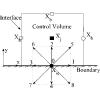当前位置:
X-MOL 学术
›
Phys. Rev. E
›
论文详情
Our official English website, www.x-mol.net, welcomes your
feedback! (Note: you will need to create a separate account there.)
Analysis and assessment of the no-slip and slip boundary conditions for the discrete unified gas kinetic scheme
Physical Review E ( IF 2.2 ) Pub Date : 2020-02-21 , DOI: 10.1103/physreve.101.023312 Liuming Yang , Yang Yu , Liming Yang , Guoxiang Hou
Physical Review E ( IF 2.2 ) Pub Date : 2020-02-21 , DOI: 10.1103/physreve.101.023312 Liuming Yang , Yang Yu , Liming Yang , Guoxiang Hou

|
The discrete unified gas kinetic scheme (DUGKS) with a force term is a finite volume solver for the Boltzmann equation. Unlike the standard lattice Boltzmann method (LBM), DUGKS can be applied on nonuniform grids. For both the LBM and DUGKS, the boundary conditions need to be processed through the density distribution function. So researchers introduced the boundary conditions from the LBM frame into the DUGKS. However, the accuracy of these boundary conditions in the DUGKS has not been studied thoroughly. Through strict theoretical deduction, we find that the bounce-back (BB) scheme leads to a different dependence of the numerical error term in the DUGKS as compared to the LBM. The error term is influenced by the relaxation time and the body force. And it can be reduced by lowering the kinetic viscosity. Unlike the BB scheme, the nonequilibrium bounce-back scheme has the ability to implement real no-slip boundary condition. Furthermore, two slip boundary conditions incorporated with Navier's slip model are introduced from the LBM framework into the DUGKS. The tangential momentum change-based (TMAC) scheme can be used directly in the DUGKS because it generates no numerical error term in the DUGKS. For the combination of the bounce-back and specular reflection schemes (BSR), the relation between the slip length and the combination parameter should be modified in accordance with the numerical error term. Analysis shows that the TMAC scheme can simulate a wider range of slip length than the BSR scheme. Numerical simulations of the Couette flow and the Poiseuille flow confirm our theoretical analysis.
中文翻译:

离散统一气体动力学方案的无滑边界条件分析与评估
具有力项的离散统一气体动力学方案(DUGKS)是Boltzmann方程的有限体积求解器。与标准格子Boltzmann方法(LBM)不同,DUGGS可以应用于非均匀网格。对于LBM和DUGKS,都需要通过密度分布函数处理边界条件。因此研究人员将边界条件从LBM框架引入到DUGKS中。但是,尚未对DUGKS中这些边界条件的准确性进行深入研究。通过严格的理论推论,我们发现反弹回(BB)方案导致DUGKS中的数字误差项与LBM的依赖关系不同。误差项受松弛时间和体力的影响。并且可以通过降低动力学粘度来降低。与BB计划不同,非平衡回弹方案能够实现真正的防滑边界条件。此外,将与Navier滑动模型合并的两个滑动边界条件从LBM框架引入了DUGKS。基于切向动量变化(TMAC)的方案可以直接在DUGKS中使用,因为它在DUGKS中不产生数值误差项。对于反跳和镜面反射方案(BSR)的组合,应根据数值误差项修改滑移长度和组合参数之间的关系。分析表明,与BSR方案相比,TMAC方案可以模拟更大范围的滑移长度。Couette流和Poiseuille流的数值模拟证实了我们的理论分析。
更新日期:2020-02-21
中文翻译:

离散统一气体动力学方案的无滑边界条件分析与评估
具有力项的离散统一气体动力学方案(DUGKS)是Boltzmann方程的有限体积求解器。与标准格子Boltzmann方法(LBM)不同,DUGGS可以应用于非均匀网格。对于LBM和DUGKS,都需要通过密度分布函数处理边界条件。因此研究人员将边界条件从LBM框架引入到DUGKS中。但是,尚未对DUGKS中这些边界条件的准确性进行深入研究。通过严格的理论推论,我们发现反弹回(BB)方案导致DUGKS中的数字误差项与LBM的依赖关系不同。误差项受松弛时间和体力的影响。并且可以通过降低动力学粘度来降低。与BB计划不同,非平衡回弹方案能够实现真正的防滑边界条件。此外,将与Navier滑动模型合并的两个滑动边界条件从LBM框架引入了DUGKS。基于切向动量变化(TMAC)的方案可以直接在DUGKS中使用,因为它在DUGKS中不产生数值误差项。对于反跳和镜面反射方案(BSR)的组合,应根据数值误差项修改滑移长度和组合参数之间的关系。分析表明,与BSR方案相比,TMAC方案可以模拟更大范围的滑移长度。Couette流和Poiseuille流的数值模拟证实了我们的理论分析。











































 京公网安备 11010802027423号
京公网安备 11010802027423号